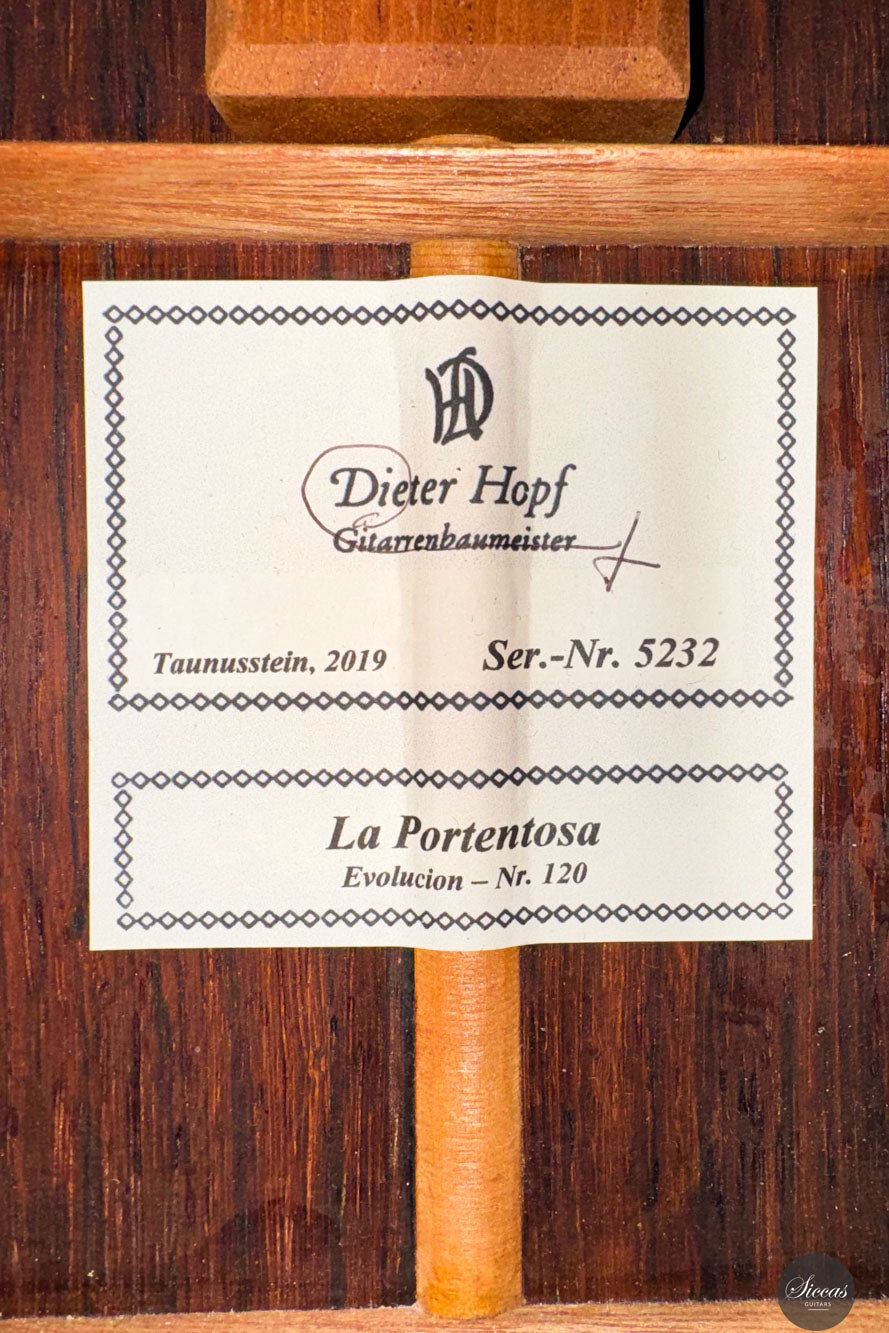Dieter Hopf - 2019 - La Portentosa Evolucion Nr.120
Dieter Hopf - 2019 - La Portentosa Evolucion Nr.120
Details
Details
Overview
Overview
Shipping important note
Shipping important note
Delivery times are typically reliable and most instruments arrive within the estimated timeframe.
Should any unexpected delay occur, our team will keep you informed and provide support at every step. For all shipping details and exceptions, please see our Shipping Policy.
Details about GPSR
Details about GPSR

























Video overview



More details about the guitar
About the luthier
The Hopf family has a long tradition of instrument making, dating back to 1669 when the name “Hopf” was first mentioned in a written document. This rich heritage has been carried forward to the present day by Dieter Hopf, who continues to uphold the family’s legacy. Born in 1936, Dieter Hopf has lived in Taunusstein since 1949. He initially trained as a violin maker in Mittenwald before shifting his focus to guitar making, earning his master craftsman certificate in 1968. Over the decades, his instruments have been played by renowned guitarists such as Alexandre Lagoya, Baden Powell, and Michael Tröster, cementing his reputation as one of Germany’s most respected luthiers.About the guitar
This 2019 *Portentosa Evolución* No. 120 is a remarkable example of Dieter Hopf’s craftsmanship, blending traditional design with modern innovations. The guitar features a cedar top paired with Indian rosewood back and sides, a combination that produces a warm, full-bodied tone with exceptional depth and clarity. The lattice-braced top, reinforced with a thin layer of carbon fiber, amplifies its loudness and projection, delivering a big, resonant sound that fills both intimate and large spaces effortlessly. Despite its power, the guitar offers surprisingly good tone separation, allowing each note to stand out clearly, making it ideal for complex musical passages. This guitar is not only powerful but also versatile, offering a tonal palette that is balanced, rounded, and rich in color. The light construction and responsive touch make it a pleasure to play, ensuring a comfortable and rewarding experience for the performer. This instrument is in very good condition, with normal signs of wear, maintaining its visual beauty and exceptional acoustic qualities.Regular care extends the life of the instrument
Even with careful use, a classical guitar may gradually change in appearance or respond to unstable storage conditions. Have a close look at your guitar regularly and be attentif to changes. If your instrument is suffering from its environement, it will let you know.
Protect Your Guitar: Handle with Care
Be mindful when touching your instrument with greasy or unwashed hands: any skin contact is a small attack on the varnish. Of course, a guitar is made to be played, but taking a few precautions helps preserve its beauty: wash your hands before playing, wear long sleeves, and avoid unnecessary direct skin contact with the body of the instrument.
Pro tip: Avoid playing with a button-up shirt, heavy jewelry, or a belt, as these can scratch the guitar. Also, make sure your guitar case is free of any objects that could damage the instrument during storage.
String care
A good habit to adopt is wiping down your strings briefly after each playing session. This small action significantly extends their lifespan and helps maintain a consistent, comfortable feel under your fingers.
Most importantly, clean strings are essential for keeping your instrument in tune. Corrosion, sweat, and dust can affect the uniformity of the strings and interfere with accurate tuning across the entire fingerboard.
Pro tip: If you're having trouble getting your guitar in tune, it might be time to change the strings. A useful test is to compare the pitch of the 12th fret harmonic with the fretted note at the 12th fret; if there's an unusually large gap between them, your strings may have lost their integrity and should be replaced.
Keep Your Shellac Finish Shining!
Got a guitar with a shellac (French polish) finish? Here's a simple trick: Take a clean microfiber cloth and gently breathe on the surface to create a light mist. Then, softly rub to remove fingerprints, sweat, and grease. That’s usually all it takes to keep it looking great, no products needed!
Pro tip: Every few years, treat your guitar to a check-up with a luthier to keep it in top shape.
Storing Your Guitar: Climate Matters
Your guitar can safely stay outside its case, as long as the surrounding environment maintains 42–55% humidity and a temperature between 18–25°C.
Keep in mind that humidity levels can still fluctuate inside the case, especially during seasonal changes.
- Too much humidity may cause overtightened strings and a dull tone.
- Too little humidity can lead to a bulging top, string buzz, or even cracks.
Avoid placing your guitar near radiators, air conditioners, or windows with direct sunlight.
Pro tip: Always close your guitar case while playing. This helps preserve a stable microclimate inside the case, so your instrument is protected the moment you put it back in.






















































